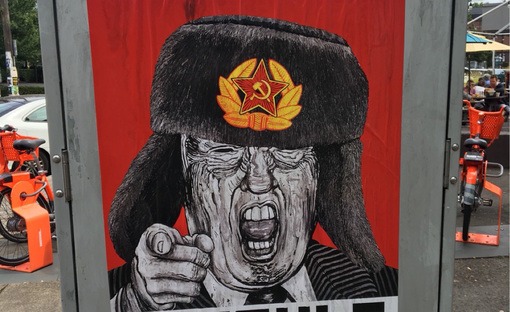
Photo by Nathaniel St. Clair
Why did Russia favor Trump over Hillary in 2016?
By the broadest definitions of “military bases” and “abroad,” Russia has 15 foreign military bases:
11 are located in “near distant” territory that was part of the U.S.S.R. until 1991, when the U.S.S.R. was dissolved;
4 are in distant foreign lands (2 active in Syria, 1 active in Vietnam, 1 inactive in Cuba);
the above total to 15; and also:
7 are active on now rented “near distant” foreign lands;
3 are now inactive on “near distant” foreign lands;
1 is active on formerly “near distant” foreign land now reincorporated into Russia (Crimea);
3 are active in distant foreign lands (2 in Syria, 1 in Vietnam);
1 is inactive in a distant foreign land (Cuba);
the last five types total to 15.
Notice that the 3 active distant foreign bases are:
– the large naval facility on the Syrian (Mediterranean) coast, at Tartus, and the nearby Khmeimim air base;
– the signals intelligence ‘spy’ post near the Golan Heights (for monitoring communications by Syrian rebel groups and the Israeli Defense Forces), which was overrun by the Free Syrian Army rebels in October 2014 (at least two other Russian intelligence centers are now assumed to be located inside Syria);
– the large naval and air force base at Cam Ranh Bay, in Vietnam.
Clearly, Russia’s only distant (not in former USSR territory) foreign military base near the Atlantic Ocean is its naval and air force facilities on the coast of Syria. It’s only other distant foreign military base is on the coast of Vietnam, and thus by the South China Sea (and Pacific Ocean).
The United States has about 800 foreign military bases in about 70 countries; and many encircling Russian in the countries now liberated from the former U.S.S.R.
So, it is easy to see that a major priority (perhaps the top priority) of Russian foreign policy would be to ensure the maintenance and security of its three distant foreign military bases, in particular its two large naval and air force bases, in Syria and Vietnam; and most particularly its coastal Syrian base complex. The Russian naval base in Syria is at a focal point between the Levant, Southern Europe and North Africa.
While Russia has a major military presence in Southeast Asia, with its base at Cam Ranh Bay, it also has a second point from which to project military power into the Pacific region (and globally by submarines): its military facilities in Vladivostok (Eastern Siberia, by the Northwest Pacific, Russia’s eastern flank). But its sole ‘distant’ foreign base on its western flank is its base (naval base and associated air force base) in Syria.
Given the above (my estimation of Russian foreign policy and military priorities) what can we deduce about Russian government preferences regarding possible American (US) regimes? In 2016 the US election was narrowed to three potential candidates: Donald Trump (for the Republicans), and either Hillary Clinton or Bernie Sanders (for the Democrats).
From the Russian perspective, Hillary Clinton as US president was most likely to start covert and overt military actions against Russian interests, a.k.a. war with Syria. That same Russian estimation of potential American foreign policies under either a President Donald Trump or President Bernie Sanders would rate the likelihood of anti-Russian (and anti-Syrian) warlike activity by the U.S. as significantly lower. So, naturally they would prefer Trump or Bernie as the US president after 2016.
Since it was obvious that the Democratic machine and entrenched bipartisan neoliberal capitalist cabal would thwart the Sanders campaign and strongly favor Hillary Clinton, Russian political analysts saw Trump as their American candidate of choice. Thus Russian propaganda and agit-prop aimed at the U.S.A. during 2016 was designed to damage the public image of Hillary Clinton (not hard to do), boost the public image of Donald Trump (not easy to do, but a fascinating challenge to clever and patriotic Russian political gamers), and to launch anti-Hillary barbs couched as rabidly pro-Sanders social media messages, which were disguised to appear as authentic expressions by Sanders’ supporters.
Trump’s vanity bristles at the idea that Russian CIA-like covert election tampering could have had any positive effect in gaining him the presidency (by disaffecting potential Hillary voters), so he angrily dismisses the idea of “Russian interference.”
Hillary’s vanity is publicly outraged by the idea that her coronation as the “first female US president” could have been derailed by “Russian interference,“ and she is no doubt ‘privately’ grateful to the Russians for providing her with another excuse to cover for her cupidity, corruption and incompetence, which put off many possible Hillary voters, and which reality was the second most important cause of her Electoral College failing grade and Trump’s success there. The most important cause of Trump’s Electoral College success, of course, was his genuine appeal to white supremacy, anti-female sexism, crony capitalism and latent fascism. These last four factors also have some appeal with the Putin Regime in Russia.
We leave it to Robert Mueller (Special Counsel investigating Russian interference in the 2016 United States elections) to ascertain the facts, but it seems fairly clear why Donald Trump and the Republican Party dislike and try to hobble the Mueller probe, and why the machine Democrats have been so strident in wanting it to continue and expand into a coup d’état by administrative procedures.
A second and more likely to be successful alternative for the Democrats to replace Trump (and many of his enabling Republicans) is by winning elections; but that would require allowing Bernie Sanders to lead the party and set its agenda. So, that’s forbidden: party over country.